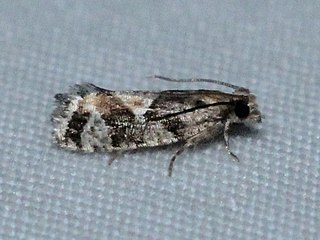
Zeiraphera isertana is a moth of the family Tortricidae. It is found in China, Russia, Europe and the Near East.

The Zeiraphera griseana, the larch tortrix, is a moth of the family Tortricidae.

Zeiraphera canadensis, the spruce bud moth, is a moth of the family Tortricidae. It is a small brown moth mainly found in North America, specifically New Brunswick, Quebec, and the north-eastern United States. The adult moth flutters quickly, and stays low among trees during the day and higher above tree cover after sunset. The spruce bud moth relies primarily on the white spruce tree as a host plant. Both male and female spruce bud moths mate multiply, however males have the ability to secrete accessory gland proteins that prevent female re-mating. The moth is univoltine, meaning only one generation hatches per year, and its eggs overwinter from July to May. The species Z. ratzeburgiana is very similar to Z. canadensis and can only be distinguished by the presence of an anal comb in Z. canadensis.

Zeiraphera is a genus of moths belonging to the subfamily Olethreutinae of the family Tortricidae.

Zeiraphera ratzeburgiana, the spruce bud moth or Ratzeburg tortricid, is a moth of the family Tortricidae. It is found from northern and central Europe to eastern Russia and China. Zeiraphera ratzeburgiana is a taxonomically similar species to Zeiraphera canadensis and can only be distinguished by an anal comb found in Z. canadensis.
Zeiraphera rufimitrana, the red-headed fir tortricid, is a moth of the family Tortricidae. It is found from central Europe to eastern Russia, Mongolia, the Korean Peninsula, China and Japan. It was first recorded from the Netherlands by Kuchlein and Naves in 1999.
Zeiraphera atra is a species of moth of the family Tortricidae. It is found in China (Shanxi), Korea and the Russian Far East.
Zeiraphera bicolora is a species of moth of the family Tortricidae. It is found in China, Japan and Russia.
Zeiraphera demutata is a species of moth of the family Tortricidae. It is found in China, Korea, Japan and Russia.
Zeiraphera fulvomixtana is a species of moth of the family Tortricidae. It is found in Taiwan, Korea and Japan.
Zeiraphera funesta is a species of moth of the family Tortricidae. It is found in China and Russia.
Zeiraphera gansuensis is a species of moth of the family Tortricidae. It is found in China.
Zeiraphera hiroshii is a species of moth of the family Tortricidae. It is found in China and Japan.
Zeiraphera lariciana is a species of moth of the family Tortricidae. It is found in China and Japan.

Zeiraphera subcorticana is a species of moth of the family Tortricidae. It is found in China, Japan and Russia.
Zeiraphera taiwana is a species of moth of the family Tortricidae. It is found in Taiwan.
Zeiraphera virinea is a species of moth of the family Tortricidae. It is found in China, Korea, Japan and Russia.
Zeiraphera hohuanshana is a species of moth of the family Tortricidae. It is found in Taiwan.
Zeiraphera thymelopa is a species of moth of the family Tortricidae. It is found in China.
Zeiraphera diniana, also known by its common name in Japan, the douglas fir cone moth, is a species of moth belonging to the family Tortricidae. The species is considered to be invasive, and is considered a pest of Larix decidua, as caterpillars defoliate the trees.




